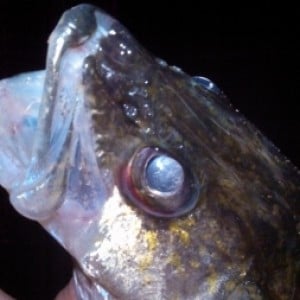So we were catching crappies in 33 FOW today. I wanted to release them, but my fishing partner said there was no way they would survive. I always thought that you could squeeze them and deflate the air sack. And if you can get them to close their mouths and swim down the hole, they would be good. Am I off base? Is there a way to safely release deep crappies like this?
IDO » Forums » Fishing Forums » Ice Fishing Forum » Releasing Deep Crappies?
Releasing Deep Crappies?
-
January 6, 2018 at 11:14 pm #1741920
I’m going to test a theory tomorrow. I’ve had em not go down the hole…..grab fish close both side of gills and blow into there mouth…..boom away they swim……( tomorrow I’m putting one in a 5 gallon pale to see if it stays alive after the performance…I’ll wait for the smart ass comments to come.
 SW Eyes
Posts: 211January 6, 2018 at 11:46 pm #1741921
SW Eyes
Posts: 211January 6, 2018 at 11:46 pm #1741921Bringing deep fish up fast will probably kill it. They may swim back down the hole, but they will have a significantly higher mortality rate.
When a fish is deep, there is more pressure. It inflates its swim bladder in a way that relates to that pressure. When you bring the fish up, it can’t deflate its swim bladder fast enough, and it expands, causing harm to the fish.
I’ve heard of people basically popping the swim bladder of Rockfish in the ocean that are brought up from hundreds of feet (it’s extreme in that case, eyes bugging out of the head and guts hanging out of their mouth) with a needle and having a higher survival rate. I wouldn’t give that a try, I wouldn’t know how you could find it without causing more damage to the fish.
Or, I think I’ve heard if you can get them back down to the depth from where they came immediately they have a better chance. They sell weighted devices you attach to your line and drop to the bottom quickly with the fish attached. You give your rod a rip and the fish disconnects. Again for ocean fish. Not sure if that’s something that would work for small freshwater fish. I’ve never heard of it being done.
If you want to release fish and have them survive, gotta fish shallow (or tske an extremely long time to real them in). I’ve heard around 25 ft is about where it becomes an issue. But, I’m not sure if that only applies to walleyes, or all species.
January 7, 2018 at 2:56 am #1741922The ones from over 25′ deep usually are “lifeless”, when I pull them out of the ice hole already.
January 7, 2018 at 7:11 am #1741932I usually make sure their mouth is closed and hold them flat in one hand and give them a slap. I believed this method worked on most of them until I read an article about Barotrauma. Google Barotrauma in fish.
 Don Wirsing
Posts: 17January 7, 2018 at 8:13 am #1741940
Don Wirsing
Posts: 17January 7, 2018 at 8:13 am #1741940I’ve watched guys try to release them in the local lake and then gone and picked dead crappies out of their holes when they leave. The muskies cruise under the ice at the local crappie hole and pick off the floaters. I’ve seen some giants. I won’t fish grubs at 30+ feet as the bluegills don’t do any better. Take your limit or what you need for a meal and don’t sort. If you want to catch and release go to a lake where they stage shallower.
January 7, 2018 at 8:40 am #1741943I’m going to test a theory tomorrow. I’ve had em not go down the hole…..grab fish close both side of gills and blow into there mouth…..boom away they swim……( tomorrow I’m putting one in a 5 gallon pale to see if it stays alive after the performance…I’ll wait for the smart ass comments to come.
No tongue and you should be good.

 nhammInactiveRobbinsdalePosts: 7348January 7, 2018 at 8:48 am #1741946
nhammInactiveRobbinsdalePosts: 7348January 7, 2018 at 8:48 am #1741946The majority of fish die over 30′. No tail slapping, blowing, reeling slow will prevent that.
It’s simply unethical to release em at those depths.
 Tom SawvellInactivePosts: 9559January 7, 2018 at 9:10 am #1741949
Tom SawvellInactivePosts: 9559January 7, 2018 at 9:10 am #1741949The last 6 or 8 years that I ice fished for crappies or sunfish I stopped fishing deep even if I was over deep water. I don’t think I ever focused on more than 16 or 17 foot depths in any water column. My reasoning was simple: I found better quality fish substantially OFF the bottom than near it that were hitting favorably. The fish found down deep were negative fish as a rule, neutral at best and often nothing more than dinks. I finally figured out that those random marks on the locator were feeding fish more than they were just roughies out for a cruise and I began targeting the water column where the random marks appeared. Better fish, no more blown out air bladders or bugged eyes.
January 7, 2018 at 9:37 am #1741956The majority of fish die over 30′. No tail slapping, blowing, reeling slow will prevent that.
It’s simply unethical to release em at those depths.
X2
You are kidding yourself to think you can save these fish. The first atmospheric pressure point bounces around the thirty foot range…. and unlike lake trout and a few others, most pan fish will not survive a release after being pulled up from that depth.January 7, 2018 at 11:00 am #1741979The following is from Gord Pyzer regarding regs but he talks about releasing deep water panfish, specifically crappie.
GORD PYZER – BIOLOGIST & OUTDOOR WRITER
There is no question that we can do a better job managing panfish populations for higher quality, but it is not always as easy as it first might seem.
On Rainy Lake and Lake of the Woods, for example, our biggest crappies are typically 14 plus years old. This means that if you keep a 14- or 15-inch crappie today, it will be 2031 before a fish hatched this year will replace it.
Also managing for high quality panfish populations demands considerations not usually necessary for bigger sport species like walleyes and bass. Crappies, in particular, are “sitting ducks” when they bunch up and congregate in deeper holes and pockets in the fall and winter because they suffer barotrauma much more easily than stronger, more physical fish.
On Sabaskong Bay, for example, our Lake of the Woods Assessment Unit once put an underwater camera under the ice and as far as they could see in any direction there were dead crappies floating belly up. These were fish ice anglers had caught, deemed to be too small, and released. But because they had been hooked in deeper water (often 25 – 30 feet) they suffered from barotrauma. Unlike more muscular bass, crappies have a difficult time swimming back down to the bottom after they’ve been released.
There are superb non-invasive tools like the Eco-Lessor that are effective, but few anglers use them. And if you talk to ice anglers, they’ll all tell you the fish they catch and release swim away safely, back down the hole. But the fact of the matter is they do not. They make it half way down, float back up and then drown under the ice. The underwater cameras showed it dramatically and conclusively.
It points to the need in many lakes, especially deeper crappie lakes, for anglers to keep the first 5 or 10 panfish they catch (whatever is the limit) and then call it a day with NO culling. But, would anglers accept this regulation? I am not sure they would.
If, for example, the limit is 10 fish, but you catch and release 30, culling up to your best 10, you’ve probably killed close to three limits and made any high quality management regulation totally meaningless.
Also, a good number, probably most of our crappie lakes in Northwestern Ontario only have relatively small lake sections conducive to crappie populations, not the whole lake. The fish are confined to small isolated sections. This, combined with the release problem above, is why they are subject to such intense “pulse fishing” and go through such dramatic boom and bust cycles and swings.
 jime
Posts: 144January 7, 2018 at 2:04 pm #1741996
jime
Posts: 144January 7, 2018 at 2:04 pm #1741996Blackbay…thanks for providing the above information.
Let’s put this information to good use and each of us
tell a couple of our fishing buddies.Thanks again,
tweed
January 12, 2018 at 6:28 pm #1743684Well as I mentioned in a earlier post about my mouth to mouth theory closing the gills completely and no tongue…..this is day 4 in the pale. He was completely motionless for 2 mins in the hole. Caught in 26 feet of water.
 Karry Kyllo
Posts: 1367January 12, 2018 at 6:45 pm #1743688
Karry Kyllo
Posts: 1367January 12, 2018 at 6:45 pm #1743688You’re saying your mouth-to-mouth resuscitation method will save a fish from barotrauma? Your intent may be good, but one fish swimming in a pail means nothing.
 nhammInactiveRobbinsdalePosts: 7348January 12, 2018 at 6:46 pm #1743689
nhammInactiveRobbinsdalePosts: 7348January 12, 2018 at 6:46 pm #1743689Im curious to what your theory is?
What does blowing into a fishes mouth do exactly, and more so, what ever made you think of doing such a thing in the first place?

 Timmy
Posts: 1265January 12, 2018 at 7:59 pm #1743706
Timmy
Posts: 1265January 12, 2018 at 7:59 pm #1743706From my experiences, I have used the “pin the mouth closed and slide them into the hole” method. They flip their tails and dart down. I have seen countless on the Vexilar that I could track all the way down to the bottom after releasing this way.
I would think they have a decent chance at survival if they get back down? This has been in 30-35 fow.
 Crappy Fisherman
Posts: 333January 21, 2018 at 12:37 pm #1746082
Crappy Fisherman
Posts: 333January 21, 2018 at 12:37 pm #1746082I have a question? Say your fishing in 30+ feet of water and the crappie come up to 20 feet do they have enough time to ajust to the pressure change?
January 21, 2018 at 1:23 pm #1746090personally when i’m fishing that deep i keep them big or small knowing the outcome more then likely releasing them would end up being a dead fish. when i got my 10 i quit.
January 22, 2018 at 8:10 am #1746300All I can tell you from the fish in the bucket is it sat motionless in the hole for a minute getting caught at 26 feet…..after closing the gills shut and blowing down its mouth I threw it in the bucket..2 weeks later it was still alive. Just released it in the lake Yesterday.
You must be logged in to reply to this topic.
